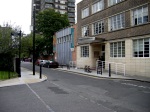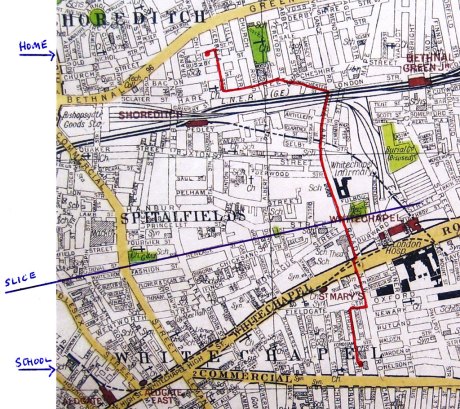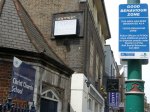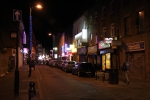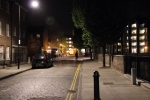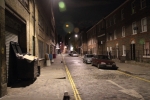BSK and the Brady Centre
June 23, 2011
Today I went to a meeting with Shamim and Bishwo Shahitto Kendro (BSK) at the Brady Centre, an East End arts centre through which the slice passes. It was very exciting – a grassroots group from the Bangladeshi diaspora engaged with various art forms. They’re going to work with Shamim and a visual artist called Zaman to explore Shamim’s idea of parents telling their children stories. There were lots of ideas and a great variety of different skills in the room – music, art, drama… We probably could have come up with a whole new slice project. I hope we’ll continue to work with BSK when we come to develop the outreach aspects of the projec.
But first things first. We’re meeting again this Sunday to start work…
Here are a couple of photos of the group, plus the Brady Centre. Oh and there was a gorgeous evening light over the eastern end of the slice, so I’m sharing a picture of that as well.
Back to School
June 20, 2011
Since my last post on my own project for Slice I’ve been doing a lot more digging and discovered that not only did my grandfather grow up closer to where I now live than I had previously realised but his future mother-in-law started her childhood in the same area – in fact she was right on Brick Lane itself. My grandfather had three East End addresses (that we know of) as a child, and the last of these is just north of Cheshire Street – which many people now know as the street with the area’s most famous expensive second-hand clothes shop: ‘Beyond Retro’. (Coincidentally this is also just yards away from the home of Emanuel Litvinoff, about whom I posted previously). I’m very aware that there’s far, far more that I don’t know about my grandfather than I do, but I know that until he left school at 14 to work for his father in the furniture trade, he went to middle school in Myrdle Street, just south of Whitechapel Road (very close to the legendary Tayyabs Pakistani restaurant). I’m still not sure where this is going artistically (and I don’t know for sure whether my grandfather moved again before he started middle school) but I thought it’d be interesting to trace his hypothetical walking to since it clearly would have to intersect the slice at some point. Here’s my best guess, using a 1920s street map:
I also though it’d be interesting to see how the area had changed, focusing for practical purposes on the area where his route (hypothetically) intersects with the slice. So I started by imposing the 1920 map onto a contemporary one:
Quite a lot of streets have disappeared, I guess through the process of tenements being replaced with post-war estates. Many streets remain however. We have in the family a 1903 book about London which, in rather purple prose, paints a picture of the ‘ghetto’ as something deeply strange – I may well use some of the text for my final piece – but for all the extreme difference I have a feeling I wouldn’t be totally lost in the 1920s, nor would my grandfather be entirely lost now. Enough streets remain. That said, I wonder if he would share my sadness at the rather characterless blocks of maisonettes that now line his old street.
I do find all the faux ‘retro’ shops springing up in the area rather pleasing though. For all that their sham ‘authenticity’ belies their commercial purpose, they are unwitting testament to just how formative the old East End is to our (albeit fanciful) idea of the true London. I wonder if young Abe, walking down Vallance Road to school, ever had a feeling that he was part of something that would become one of history’s fixed points?
Words
June 14, 2011
Shamim Azad and I walked the London slice the other day. What with sheltering from the rain, stopping off for a delicious lunch and the fact that, in the Brick Lane area Shamim gets recognised every few yards, it took us a couple of hours. Well-spent hours, mind you. It started with what seemed like an auspicious sign for an artwork that will use words: letters, caught in Liverpool Street roof structure, awaiting meaning.
The plan, roughly speaking, is for Shamim to work with a group from the community to create something. I’ll then help turn it into a suitable form for the website and installation. One idea is to work with parents to use both visual elements and words to share their experiences of arrival in the area with their children. But it might all change, so I’ll say no more just now!
We met a teacher Shamim knows from Christ Church School, which is a lovely old building, right in the heart of Brick Lane. The slice passes right through it. It’d be great to get the kids involved with the project at some stage.
London – night walk
May 28, 2011
Journey Through A Small Planet
May 27, 2011
I’m re-reading this book, a memoir by the ‘Anglo-Jewish’ poet and novelist Emanuel Litvinoff which I greatly enjoyed a few years ago, to see how his life intersects with our slice. He grew up in the Brick Lane area and mentions various places tantalizingly close to our line… I’m hoping to find something that’s bang on though, not just a street away. I wonder if I can connect our straightforward linearity to the far more organic web of routes around the streets he describes.
Even if Litvinoff doesn’t give me any joy, I think I might still be interested in exploring something related to the Jewish history of the area. Some of my family come from this background but I’ve never really investigated. I know that my grandfather lived and worked in East London for part of his life. He attended work functions at the Great Eastern Hotel, part of Liverpool St Station. That’s definitely on the line but I’m not sure I can yet see a piece of work about the annual gathering of the British Furniture-makers’ Association. Not quite sure where this is leading but it’s worth some more digging…
Oh and if none of that works out, I also have an idea brewing about the relationship between the cross-section created when our line slices through a block of flats and the theoretical notion of a cross-section of society, as represented by the area’s demographic information.



